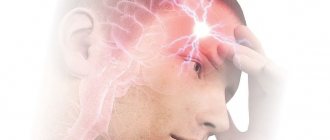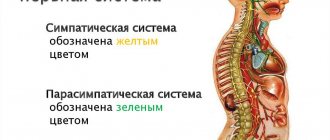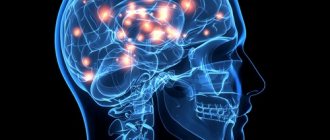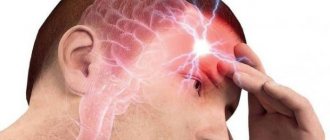One of the most common pathologies in the modern world is vegetative-vascular dystonia. It is diagnosed in 80% of the population. In pediatric practice, VSD is detected in 25% of cases. However, there is still no consensus regarding the definition of pathology.
Vegetative-vascular dystonia is a symptomatic complex that includes damage to various organs and systems. In order to diagnose the disease, determine the causes of its development and carry out the correct treatment, we recommend contacting the Yusupov Hospital. For research, the clinic’s specialists use equipment that meets quality and safety standards. Therapy is prescribed according to the latest international recommendations.
The formulation of VSD is found only in domestic medicine. However, there is no such disease in the international classification of diseases ICD-10. The symptom complex is combined into such a concept as “autonomic dysfunction” (ICD-10 code F 45.3).
Causes
Vegetative-vascular dystonia affects various systems and organs. Symptoms may appear already in fetal development. It has been proven that the largest number of diagnosed cases are detected between the ages of 20 and 40 years. Among the main reasons for the development of VSD are the following:
- hereditary burden;
- physiological features of the structure of the body;
- psycho-emotional or physical stress;
- hormonal instability;
- chronic somatic pathologies;
- history of traumatic brain injury.
Doctors at the Yusupov Hospital quickly identify the causes of the development of vegetative-vascular dystonia.
In accordance with the identified etiological factors, a treatment program is developed. Make an appointment
VSD of mixed type
Depending on how the cardiovascular system reacts to a disorder of the autonomic nervous system, the 3 types of VSD described above are conventionally distinguished. But, as a rule, vegetative-vascular dystonia includes several types of symptoms at once.
The mixed type is characterized by a combination of the above symptoms. Blood pressure “jumps”, a person feels sometimes depressed, sometimes irritated, sometimes experiences weakness, sometimes excessive emotional overexcitation, and his mood changes sharply. With a mixed type of VSD, the whole spectrum of symptoms can manifest itself: cardiac and respiratory arrhythmia, panic attacks, pain with vague localization. This type of autonomic disorder is the most common.
Kinds
Doctors distinguish the following forms of vegetative-vascular dystonia:
- according to the hypertensive type;
- hypotonic type;
- according to the cardiac type;
- mixed type.
VSD of the hypertensive type. This type of pathology is accompanied by rises in blood pressure to high values. In this regard, headache, dizziness, weakness, flashing “spots” before the eyes, and a feeling of nausea appear. VSD of the hypotonic type. A symptom of this form of pathology is a decrease in blood pressure. Difficult to diagnose due to the general nature of the manifestations. Mixed type VSD is characterized by regular changes in blood pressure from high to low values. Mixed vegetative-vascular dystonia most often appears due to a hereditary predisposition. Clinical symptoms of this form of the disease are panic attacks, increased anxiety, and irritability. VSD of the cardiac type Occurs against the background of other diseases. It manifests itself as pain in the heart area.
Expert opinion
Author:
Tatyana Aleksandrovna Kosova
Head of the Department of Rehabilitation Medicine, neurologist, reflexologist
According to the latest statistics, VSD is diagnosed in 50–70% of the population. At the same time, it is not possible to identify a pattern regarding age and gender. The onset of the disease can occur at any period of life. Among adolescents, vegetative-vascular dystonia is detected in 25–40% of cases.
VSD refers to a complex of pathological symptoms united by a common concept. Diagnosing the disease can be difficult due to the variety of clinical signs. At the Yusupov Hospital, ECG and EchoCG are prescribed for examination. In addition, MRI, CT, 24-hour Holter monitoring, EEG and laboratory tests are used. Based on the results of a comprehensive diagnosis, doctors select the correct therapy. The amount of treatment depends on the severity of symptoms. Depending on the prevailing symptoms, certain groups of drugs are prescribed.
Patients often underestimate the danger of VSD. Without treatment, the disease becomes more complicated. This worsens the patient's condition and requires serious therapy. Therefore, when the first pathological signs appear, it is recommended to consult a doctor. Timely diagnosis and quality treatment are the key to a speedy recovery.
Causes and symptoms of VSD
Adolescents and women are at risk for developing vegetative-vascular dystonia. In men, VSD rarely occurs as an independent syndrome; dystonia is usually associated with other diseases. The causes of the pathology are most often unknown, but its appearance is associated with the following provoking factors:
- stress – constant nervous tension causes the release of stress hormones, which stimulate the autonomic nervous system;
- hormonal changes - physiologically in women during the menstrual cycle, with the onset of pregnancy, menopause, the concentration of sex steroids changes, which indirectly affect the functioning of the nervous system;
- maturation of the nervous system – in adolescents leads to pronounced signs of VSD;
- bad habits - smoking, drinking alcohol, caffeinated drinks cause disturbances in the functioning of blood vessels and the conduction of nerve impulses.
The first symptoms of vegetative dystonia may appear in childhood. They are associated with heredity and characteristics of pregnancy. If the expectant mother suffers from vegetative-vascular dystonia, smokes, and has been diagnosed with arterial hypertension, then the risk of pathology in the child increases significantly. The health of the baby is negatively affected by intrauterine hypoxia, disruption of feto-placental blood flow, as well as the stress experienced by the pregnant woman. Acute fetal hypoxia during childbirth can also lead to the formation of VSD at an early age.
The formation of vegetative-vascular dystonia in adults can be associated with osteochondrosis, head injuries, and poor nutrition. Prolonged life in poor environmental conditions and work in hazardous industries also leads to VSD. Weather-dependent people also often experience dystonia.
Symptoms of autonomic dysfunction are varied; doctors identify more than 40 signs of the disease, but not all of them occur in one patient. Usually this is a combination of 4-5 constant symptoms and several additional ones. Depending on the manifestations of the cardiovascular system, there are three types of vegetative-vascular dystonia:
- cardiac - not accompanied by pressure surges, it is characterized by pain in the heart area or interruptions in its work;
- hypertensive type - a person suffers from high blood pressure, which is accompanied by panic attacks, chills, and increased physical activity;
- hypotensive type – characterized by low blood pressure, which is maintained at 100/50-90/45 mm Hg. Additional concerns include weakness, drowsiness, and dizziness.
Signs of dystonia include periodic shortness of breath, a feeling of shortness of breath, or a sensation of spasm in the throat. Many people complain to the doctor about pain in the heart, a feeling of increased heartbeat, pressure in the chest, interruptions in the heart, but it is rarely possible to record them using an ECG. Symptoms of autonomic dysfunction include decreased appetite, heartburn, flatulence and other digestive disorders. The disease manifests itself in the form of frequent urination or urinary retention, chills and cold extremities, and increased sweating. Many people complain of weather sensitivity, sleep disturbances, mood swings and irritability. In women with VSD, the menstrual cycle may be disrupted or symptoms of premenstrual syndrome may appear 1-2 weeks before menstruation.
The severity of signs of vegetative-vascular dystonia may vary. Depending on the frequency of symptoms, the following types of disease are distinguished:
- paroxysmal – attacks of vegetative-vascular dystonia periodically appear;
- permanent - the symptoms of dystonia are constant, usually mild, but can intensify under the influence of provoking factors;
- mixed - includes characteristics of the two previous types;
- latent type - signs of the disease appear only after severe stress, the rest of the time the symptoms do not bother.
Vegetative-vascular dystonia, if prolonged without treatment, can lead to disturbances in the functioning of the heart. People who are overweight, eat poorly, and suffer from physical inactivity have an increased risk of developing coronary heart disease and hypertension. In women aged 45-50 years, VSD aggravates the course of menopause.
Symptoms
Due to the fact that vegetative-vascular dystonia affects various organs and systems, the pathology has a variety of clinical manifestations. The nervous, cardiovascular, and genitourinary systems may be involved in the process. As a result, a misleading impression of the presence of other diseases is created. Experienced doctors at the Yusupov Hospital carry out differential diagnosis of conditions and identify VSD in the shortest possible time. Common symptoms of pathology are:
- Psychoneurotic: headaches, dizziness, anxiety, tearfulness. Patients are concerned about irritability, a tendency to panic attacks, sleep disturbances, daytime sleepiness, and apathy.
- Respiratory: periodic attacks of suffocation, feeling of lack of air, shortness of breath, rapid breathing, inability to take a deep breath.
- Cardiac: rapid heartbeat, feeling of pain in the heart area, chest tightness, irregular heart rhythm.
- Peripheral somatic syndromes: arthropathy, myopathy, osteochondrosis of the cervical spine.
- Genitourinary: erectile dysfunction, urination and defecation disorders.
- Thermoregulatory: changes in body temperature, feeling of chills.
- Dyspeptic: abdominal pain, feeling of nausea, increased gas formation. The stool becomes unstable, heartburn and belching appear.
Numerous positive reviews indicate the successful work of the Yusupov Hospital specialists. Doctors have been successfully identifying VSD for many years, despite the complexity of diagnosis.
Symptoms for different forms of VSD
Patients with the cardiac form of VSD are bothered by pain in the heart of a stabbing, aching, pressing nature that does not go away after taking nitroglycerin.
Patients feel palpitations, cardiac tremors, and interruptions in the functioning of the heart. The pulse can be frequent or rare, blood pressure can be low or high. During an exacerbation of VSD symptoms, patients experience a feeling of fear of death and a “lump in the throat.” They cannot calm down, rush about and demand urgent action. A panic attack unsettles a person from normal life. After an attack, patients remain fearful for a long time.
A sign of VSD is insomnia and impaired sleep quality. After a sleepless night, the patient feels exhausted and his mood worsens. The smallest trigger factor can throw a VSD patient out of balance. If VSD occurs of the respiratory type, patients experience attacks of suffocation, dissatisfaction with inhalation, chest pain, and a feeling of lack of air.
Patients suffering from hypotonic type VSD lose consciousness during a vegetative crisis, their skin becomes pale and sweaty, and their legs and arms become cold.
Dysfunction of the digestive system is manifested by heartburn, nausea with vomiting, diarrhea or constipation. Patients are bothered by cramping pain in the abdomen.
Patients with vegetative-vascular dystonia complain of pain in the joints and muscles, and they develop osteochondrosis.
In the mixed form of VSD, manifestations of all types of vegetative-vascular dystonia are determined. VSD of the hypertensive type is usually combined with functional venous hypertension, respiratory and myocardial syndromes, arterial hypotension - with respiratory syndrome and functional venous hypertension, less often with myocardial syndrome.
The cardiac form of neurocirculatory dystonia is most often combined with respiratory syndrome, functional venous hypertension and regional cerebral dystonia. Functional venous hypertension as a leading syndrome is determined in combination with myocardial and respiratory syndromes. During a crisis, all symptoms of VSD worsen. The attack begins suddenly and goes away.
Dizziness
The cause of dizziness during VSD may be a violation of cerebral vascular tone. The condition of cerebral vessels is influenced by many factors - from unpleasant news to the release of adrenaline into the blood due to stress. The catalyst for reactions that develop during VSD are:
- mental stress;
- acute and chronic stress;
- burdened heredity;
- diabetes mellitus and other chronic diseases;
- diseases of the central and peripheral nervous system;
- pathology of the thyroid gland, adrenal glands, gonads.
In case of dizziness due to VSD, neurologists at the Yusupov Hospital examine patients using modern devices from the world's leading manufacturers.
Patients undergo magnetic and magnetic resonance imaging, radiography of the cervical spine, and electroencephalography. If an exacerbation of VSD symptoms occurs due to a decrease in blood pressure, coffee and green tea, a piece of dark chocolate, and lemongrass tincture help. You can add a spoonful of honey to the tea. In case of a severe attack of vegetative-vascular dystonia, the patient should be laid down and fresh air should be allowed into the room. Treatment begins with a sedative or sedative. After measuring blood pressure, a decision is made on the advisability of drug therapy.
The cause of dizziness during VSD may be a pathology of the cerebral vessels. How to strengthen cerebral vessels during VSD? To increase the elasticity of the walls of arteries and capillaries, neurologists prescribe the following medications for cerebral vessels:
- vitamin C is an antioxidant, whose role is to protect the walls of blood vessels from destruction under the influence of free radicals, enhances the functions of vitamin P;
- vitamin P – contains a complex of polyphenols and bioflavonoids, which help strengthen capillaries and prevent the loss of vascular tone;
- nicotinic acid (vitamin PP) - expands capillaries and prevents the deposition of cholesterol on the walls of blood vessels.
If you feel dizzy with VSD, medications are prescribed that contain microelements that strengthen the walls of blood vessels and stimulate metabolism: potassium, selenium, silicon.
How to relieve dizziness with VSD? The pharmaceutical industry produces herbal preparations that improve blood circulation in the brain. These are nicotinic acid derivatives, products based on garden periwinkle and Ginkgo Biloba extracts. Nicotinic acid derivatives dilate large vessels, although small capillaries are also affected by them.
Ginkgo Biloba extracts are included in the preparations Tanakan, Bilobil, Ginkor Fort. When taken orally, they perform several tasks:
- relieve vasospasm;
- increase the permeability of the vascular wall;
- relieve swelling;
- has an antioxidant effect;
- accelerate metabolism in nervous tissue.
Garden periwinkle contains a special group of alkaloids that have a pronounced antispasmodic effect on blood vessels, accelerate metabolism, and increase microcirculation in the vessels of the brain. Mexidol helps well against dizziness with VSD.
Headache Syndrome of vegetative-vascular dystonia manifests itself in many ways.
Headache, as the most important symptom of VSD, occurs mainly in people who are susceptible to fears and phobias, strong emotions after stress. How does a headache hurt with VSD? Patients give the following description of headaches with VSD:
- is not strong and harsh;
- may be accompanied by fainting, nausea, dizziness, ringing or noise in the ears, unsteadiness of gait;
- begins in the morning, does not leave a person all day and is distinguished by its constancy;
- in pain, the patient has difficulty perceiving the world around him;
- When you tilt your head, the pain intensifies and becomes throbbing.
During a headache attack, the patient feels as if he is wearing a helmet and is squeezing his head.
Where does the headache occur with VSD? The pain is localized in a specific area or spreads throughout the head. Patients feel a feeling of discomfort in the back of the head and neck. During an attack, one ear may become blocked; sometimes the patient feels as if there is something pressing in the temples, eyes and forehead. To get rid of headaches, neurologists at the Yusupov Hospital suggest that patients eliminate traumatic factors, bad habits, normalize work and rest patterns, and nutrition. Hypnosis, manual therapy, and acupuncture are effective in treating headaches due to autonomic disorders. Doctors at the Yusupov Hospital are fluent in non-drug treatment methods and use proprietary rehabilitation methods.
Make an appointment
What is VSD
Vegetovascular dystonia (VSD), or neurocirculatory syndrome, is a functional disorder of the autonomic nervous system, in which a complex of symptoms appears that are not characteristic of a specific disease. Examination of patients with suspected VSD most often does not reveal changes in the structure of internal organs, but may show deviations in their function at the border of normal.
Autonomic dysfunction cannot be called a full-fledged disease; this diagnosis is not included in the International Classification of Diseases (ICD-10). But therapists, cardiologists and neurologists continue to make this diagnosis to patients in whom the examination did not reveal any disorders, and complaints of poor health continue.
It is believed that manifestations of pathology arise due to disturbances in the coordination of the two structures of the autonomic nervous system. It consists of the sympathetic and parasympathetic systems, which differ in their effects on the body. The activator of sympathy is the hormone adrenaline, so it performs the following functions:
- increases the number of heart contractions;
- increases blood pressure;
- stimulates the release of glucose into the blood;
- dilates the arteries of the brain, lungs and heart;
- reduces saliva secretion;
- suppresses peristalsis of the digestive tract;
- dilates the bronchi and enhances gas exchange;
- enlarges pupils;
- causes spasm of the sphincters of the bladder and digestive tract.
These reactions are necessary to protect the body in a dangerous situation, to activate it to escape. The parasympathetic nervous system works in the opposite direction. It reduces blood pressure, accelerates peristalsis of the intestines and urinary organs, and constricts the pupils and bronchi. The parasympathetic activator is the substance acetylcholine. It slows down the heartbeat, reduces blood glucose levels and relaxes all the sphincters in the body.
Autonomic dystonia occurs when the sympathetic or parasympathetic system is activated spontaneously, for no apparent reason. Therefore, a person suddenly has an increased heartbeat while at rest, his blood pressure rises, and he is worried about anxiety.
But often vegetative-vascular dystonia is a precursor to serious diseases. Having arisen at a young age without treatment, after a few years it leads to the formation of arterial hypertension, heart disease, digestive tract and hormonal disorders.
Diagnostics
Vegetative-vascular dystonia has various clinical manifestations. In this regard, it is necessary to carefully carry out diagnostics to differentiate pathological conditions. The main research methods include:
- clinical blood test;
- biochemical blood test;
- general urine analysis;
- blood for thyroid hormones;
- rheoencephalography;
- ECG;
- EchoCG;
- 24-hour Holter monitoring;
- MRI.
Doctors at the Yusupov Hospital use modern equipment. With their help, it is possible to establish the causes of vegetative-vascular dystonia in the shortest possible time. Experienced specialists select effective treatment aimed at eliminating the symptoms of the pathological condition.
Diagnosis and treatment of autonomic cardiac dysfunction
Autonomic dysfunction is a diagnosis of exclusion. After a number of cardiovascular diseases have been excluded thanks to laboratory and instrumental methods (ECG, EchoCG, Holter-ECG, etc.), differential diagnostics should be carried out with neuropsychiatric diseases and only in the last place should one think about vegetatives.
Treatment of a disorder of the autonomic nervous system itself should begin with improving lifestyle: regular physical activity, sports (swimming is a priority), elimination of bad habits, a good night's sleep, optimal nutrition, normalization of body weight, hardening.
Medicines used include adaptogens, daytime tranquilizers, nootropics, vascular drugs, antioxidants, and vitamins.
Treatment
Therapy for vegetative-vascular dystonia begins with a visit to a psychotherapist and lifestyle changes.
Medicines are used exclusively in complex treatment. The drug and dosage are determined by doctors at the Yusupov Hospital after examining the patient. For VSD, neurologists prescribe the following medications:
- antidepressants;
- sedatives;
- tranquilizers;
- nootropic drugs.
Antidepressants are necessary to get rid of the manifestations of depressive conditions that are observed with vegetative-vascular dystonia.
Medicines quickly relieve anxiety and depression, improve sleep quality and increase appetite. For vegetative dystonia, antidepressants are prescribed first, since eliminating depression simultaneously reduces other manifestations of VSD. With prolonged use, the drugs are addictive. Antidepressants cause side effects that include various disorders of the central nervous system, increased sweating, heart rhythm disturbances and nausea. Doctors at the Yusupov Hospital are careful when choosing a drug for the treatment of VSD. The most harmless and effective antidepressants are azafen, deprim, cipralex. Sedatives reduce anxiety. In the treatment of VSD, drugs based on medicinal herbs, barbiturates, bromine and magnesium preparations are used. Herbal remedies are considered the safest, since they have minor side effects and do not have significant contraindications. For VSD, neurologists use drugs based on valerian extract (Novo-Passit, Dormiplant, Persen) and hawthorn (Kralal, Fitosed). Barbiturates have significant side effects. They can be addictive, and if the dosage is slightly exceeded, they can lead to poisoning. The safest drugs in this group are Corvalol, Barboval, Valocordin. They are prescribed for the cardiac form of VSD.
Tranquilizers are effective medications that provide a quick but short-term sedative effect. They relieve feelings of fear, worry, anxiety, and relieve emotional stress. Drugs of this pharmacological group are not prescribed during pregnancy and weakened immunity, children and mental patients. VSD therapy is carried out with gentle medications with a gradual transition to more powerful drugs. To treat VSD, doctors use diazepam, nozepam, oxazepam, seduxen, and elenium.
Nootropic drugs include drugs that affect certain brain functions:
- activate mental activity;
- improve memory;
- increase learning abilities.
The use of drugs in this group relieves patients with VSD from weakness and apathy, promotes clarity of consciousness, and eliminates psychomotor retardation. Nootropics have mild side effects and low toxicity. Most often, doctors prescribe glycine, phenibut, piracetam, nootropil, and fezam for VSD.
Complications
Many people do not attach importance to such a diagnosis as vegetative-vascular dystonia. This opinion is wrong. Like any disease, VSD can lead to complications. Among them:
- hypertension;
- hypotension;
- visual impairment;
- anemia;
- depression;
- weight loss;
- involuntary urination.
In this regard, doctors recommend seeking medical help when the first pathological signs appear. This will help to identify the problem in time and carry out a course of treatment.
VSD of cardiac type
In the cardiological (as well as in the hypertensive) form of autonomic dysfunction, the diagnosis will most likely show obvious sympathicotonia, that is, functional tension in the work of the sympathetic department of the ANS. A distinctive feature of VSD of the cardiac type is pain in the heart area (stabbing, pressing or burning sensations in the chest area). Signs may resemble those of an angina attack or myocardial infarction. But upon examination, cardiac pathologies are not detected.
The cardiac type of reaction to a vegetative-vascular disorder is characterized by: tachycardia, cardiac arrhythmia, false pain in the heart area, as well as respiratory arrhythmia and asthma attacks. It is important to understand that with VSD, pain in the heart area is not a harbinger of a heart attack and does not in any way affect the cardiovascular system, which will be confirmed by the patient’s echocardiogram. Cardiac rhythmography is very effective in diagnosing this type of VSD.
Prevention
In order to reduce the risk of developing symptoms of VSD, the following preventive recommendations must be followed:
- to live an active lifestyle;
- avoid psycho-emotional stress;
- do not abuse alcohol or caffeine-containing drinks;
- stop smoking;
- adhere to a rational and balanced diet.
These medical advice will help minimize the possibility of vegetative-vascular dystonia.
When the first signs of pathology appear, you must contact a doctor for a medical examination. Doctors at the Yusupov Hospital in Moscow will perform a full course of diagnostics necessary to identify vegetative-vascular dystonia. They will prescribe treatment that will relieve the unpleasant symptoms of the disease.
You can ask questions or make an appointment with a doctor by phone.
Make an appointment











